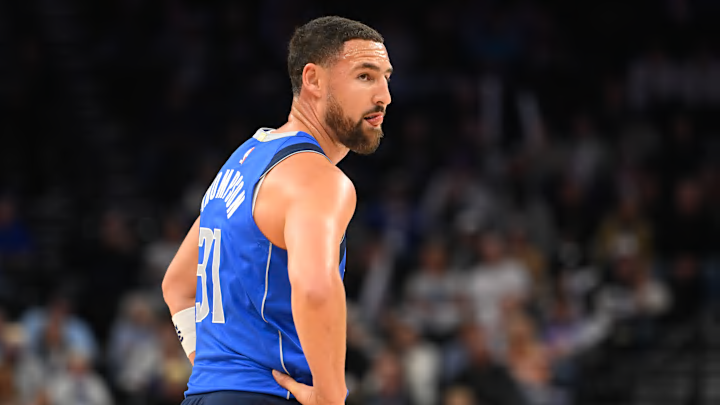The Dallas Mavericks have made the agonizing decision to move four-time NBA champion Klay Thompson to the second unit. Thompson started each of his first 79 games with the Mavericks, including the first seven outings of the 2025-26 season, but a change was made in the face of adversity.
With Dallas losing five of its first seven games, the decision was made to start Max Christie and D'Angelo Russell—a wise choice that should benefit Thompson, as well as the team at large.
Dallas has struggled in several areas early in 2025-26. Arguably its biggest issues are reflected in that, on a per-game basis, it currently ranks No. 22 in potential assists, and No. 28 in assists and fast break points allowed.
All three of those statistics point to the need for improved playmaking and an influx of athleticism along the perimeter to balance out a frontcourt-heavy rotation.
Thompson has struggled individually, shooting just 34.2 percent from the field and 29.2 percent from beyond the arc. The decision to move him to the second unit is less of a reflection of his production, however, and more an acknowledgment of the reality of the importance of fit.
Thompson is still capable of providing winning minutes, but Dallas needs playmaking, athleticism, and defense in the backcourt—contributions Thompson isn't necessarily ideal to ask for.
Klay Thompson simply wasn't an ideal fit for Mavericks starting lineup
There was a time when Thompson had set the standard for the rest of the NBA as far as 3-and-D players were concerned. In addition to being perhaps the greatest catch-and-shoot marksman in Association history, he proved capable of defending players at multiple positions.
Not only was Thompson versatile in that regard, but the results he produced were often elite on both ends of the floor within the definition of his role.
In 2025-26, however, Thompson is 35 years of age and on the other end of two career-threatening injuries. He tore his ACL at 29 and suffered a torn Achilles tendon at 30, thus resulting in the four-time NBA champion missing the entire 2019-20 and 2020-21 seasons.
After two years away from the game, Thompson played just 32 games in 2021-22, but has since appeared in at least 69 outings in each of the past three seasons.
Even with improved availability, however, Thompson has encountered the inevitabilities of Father Time and post-injury realities. He's a step slower defensively, and while not necessarily a bad defender, isn't capable of locking opponents down on a nightly basis.
That may not be a flaw, but the Mavericks' roster structure requires the starting shooting guard to specialize in both floor spacing and defensive play.
Klay Thompson is perfect for Mavericks' sixth man role
Thompson can still excel in those areas, but he doesn't seem to be ideally suited for a demanding defensive role. Dallas has overloaded its rotation with bigs and 3s who should probably be 4s, thus making the presence of athleticism and consistent defense essential attributes in the backcourt.
Thankfully, in a sixth man role that will ask Thompson to come in, shoot the lights out, and defend as he can, the Mavericks have finally positioned him for a resurgence.
Thompson may not be shooting well in 2025-26, but he's still one of the best shooters in NBA history. He buried 39.1 percent of his threes in 2024-25 and should return to that level if positioned to function in a role that allows him to focus on his threes.
As the potential sixth man, the Mavericks can empower Thompson to do exactly that in a role that prioritizes scoring and spacing as his primary objectives.
Anything else that Thompson is able to provide from there would be icing on the proverbial cake. In his new role, however, the pressure has been lifted, his strengths have been highlighted, and the starting lineup's needs have been addressed.
It may have taken 90 games to get here, but the Mavericks have finally figured out how to properly utilize Thompson. In time, the risk will pay off.
